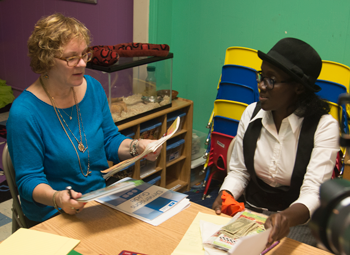
So far, we have looked at how the look-for text and the CLASS language charts can support teacher learning. For part 3 of this series, let’s examine how the reflective questions in myTeachstone can encourage teacher engagement and reflection.
Did you know that every myTeachstone resource includes its own set of open-ended, reflective questions? Here is one example.

But before we dig into myTeachstone, let's begin with a few of our own reflective questions.
- What is a reflective question?
- How do reflective questions invite teachers to engage and extend their learning?
The answers to these questions will begin our discussion on why reflection is an essential component of professional development.
- The word reflect has many meanings. It can mean to “cast back,” “show an image of,” “reproduce,” “bring credit,” and “think, ponder, or meditate.” All of these definitions can be helpful in building our understanding and use of reflective questions. When coaches ask reflective questions they are casting back the observations (images) to teachers and encouraging them to reproduce their own intentions related to their interactions. Reflective questions give credit to the teachers, reminding them that their words and actions are important, and they prompt teachers to think more deeply.
- We know that instructional interactions that prompt analysis and reasoning and create connections between current and previous learning are crucial in developing children’s higher-order thinking. The same is true for adult learners. When coaches ask reflective questions about resources and make connections to teachers’ daily practice, teachers develop the ability to think critically and intentionally about their work. This thinking is what turns into action and enhanced interactions (especially when coupled with supportive action plans and follow-up).
But here’s the catch. Asking effective questions is hard. For everyone. Even seasoned coaches can struggle with asking effective questions. Many coaches don’t have the time to devote to planning conferences as they would hope. Teachers’ responses to questions can vary and coaches may not always know how to follow up.
The reflective questions included with each myTeachstone resource can help. The questions are already created for you. These questions can be used as conversation starters or as follow-up to teachers’ thoughts on the resource.
We’re going to end this series a little differently. We’re giving you homework!
Watch the video Itsy Bitsy Dog (if you have been keeping up with previous posts, you've seen this video before!), and think about how you might use this resource to engage teachers in conversation. Think about each of type of bonus content: the look fors, charts, and reflective questions.
Now think about a teacher that would benefit from watching and discussing this resource. Recommend it and use the look fors, charts, and questions to start your discussion. Encourage the teacher to use each part of the content to extend learning.
Don’t be shy! Please let us know how it goes. What was helpful? How did the teacher respond to the strategies you used and questions you asked?
...And keep on the lookout for a series on how to create your own reflective questions!

